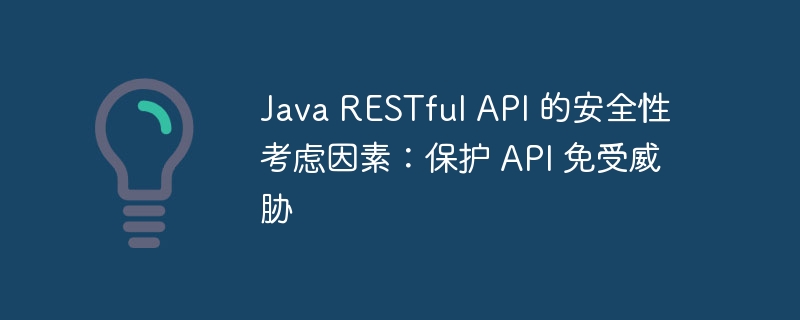Home >Java >javaTutorial >Security Considerations for Java RESTful APIs: Protecting APIs from Threats
Security Considerations for Java RESTful APIs: Protecting APIs from Threats
- WBOYWBOYWBOYWBOYWBOYWBOYWBOYWBOYWBOYWBOYWBOYWBOYWBforward
- 2024-03-09 09:16:18920browse

The security of Java RESTful API has always attracted much attention, and protecting the API from threats is an issue that developers must pay attention to. When designing and developing RESTful APIs, many security factors need to be considered, such as authentication, authorization, data encryption, preventing CSRF attacks, etc. In this article, PHP editor Zimo will discuss in detail the security considerations of Java RESTful API, helping developers establish a robust security protection mechanism to ensure the safe transmission and processing of API data.
Authentication is the process of verifying who a user is. For RESTful api, it can be implemented in the following ways:
-
Basic Authentication: Send the username and password to the server via Base64 encoding.
@PostMapping("/login") public ResponseEntity<Void> login(@RequestBody UserCredentials credentials) { // 验证凭证并生成 Jwt 令牌 } -
JWT Token: JSON WEB A token (JWT) is a compact signed token that contains user-identifying information.
@GetMapping("/protected-resource") public ResponseEntity<ProtectedResource> getProtectedResource() { // 从请求中提取 JWT 令牌并验证 } -
OAuth2: OAuth2 is a mechanism for delegation of permissions that allows third-party applications to access protected resources on behalf of users.
@RequestMapping("/oauth2/authorization-code") public ResponseEntity<Void> authorizationCode(@RequestParam String code) { // 兌換授權碼以取得存取令牌 }
Authorization
Authorization determines which API resources a user can access. This can be achieved by:
-
Role-Based Access Control (RBAC): A role is a collection of a set of permissions that a user has.
@PreAuthorize("hasRole("ADMIN")") @GetMapping("/admin-resource") public ResponseEntity<AdminResource> getAdminResource() { // 僅限具有「ADMIN」角色的使用者存取 } -
Resource-Based Access Control (RBAC): Permissions are assigned directly to resources, for example, a specific user can edit a specific record.
@PreAuthorize("hasPermission(#record, "WRITE")") @PutMapping("/record/{id}") public ResponseEntity<Void> updateRecord(@PathVariable Long id, @RequestBody Record record) { // 僅限具有「WRITE」許可權的使用者可以更新記錄 }
data verification
Data validation ensures that data submitted via the API is valid and secure . This can be achieved by:
-
Joi: Joi is a popular javascript library for validating and sanitizing user input.
import io.GitHub.classgraph.ClassGraph;
// Use Joi to validate user input
@PostMapping("/user")
public ResponseEntity
* **Jackson:**Jackson 是一个用于将 Java 对象序列化和反序列化的库,它提供了内置的验证功能。
```java
@PostMapping("/product")
public ResponseEntity<Void> createProduct(@RequestBody Product product) {
// 使用 Jackson 驗證產品資料
ObjectMapper mapper = new ObjectMapper();
mapper.configure(DeserializationFeature.FaiL_ON_UNKNOWN_PROPERTIES, true);
}
encryption
Encryption is used to protect data transmitted through the API. This can be achieved by:
-
SSL/TLS Encryption: SSL/TLS encryption creates a secure connection between the API and the client.
@Configuration @EnableWebSecurity public class WebSecurityConfig extends WebSecurityConfigurerAdapter { @Override protected void configure(httpsecurity Http) throws Exception { // 將請求強制導向 HTTPS http.requiresChannel().anyRequest().requiresSecure(); } } -
JWT Token Signing: JWT tokens are signed using a cryptographic key.
@Bean public JwtEncoder jwtEncoder() { // 使用 256 位 AES 密鑰產生 JWT 編碼器 return new JoseJwtEncoder(new Aes256JweAlGorithm()) } -
Data Encryption: Sensitive data can be encrypted in the database or in memory.
@Entity public class User { @Column(name = "passWord") private String encryptedPassword; @PrePersist public void encryptPassword() { encryptedPassword = PasswordEncoder.encrypt(password); } }
By taking these steps, developers can improve the security of their Java RESTful APIs from unauthorized access, data leakage, and other threats. Regularly reviewing security measures and updating APIs to adapt to new threats is critical to ensure ongoing security.
The above is the detailed content of Security Considerations for Java RESTful APIs: Protecting APIs from Threats. For more information, please follow other related articles on the PHP Chinese website!

